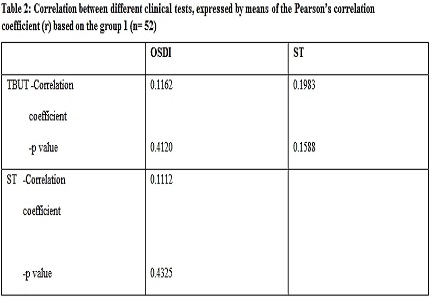Correlation between ocular-surface disease index questionnaire, tear film break-up time and schirmer tests for evaluation of the tear film in patients of dry eye syndrome
Abstract
Background: The purpose of this study is examining the correlation between clinical tests in patients of dry eye.
Methods: Medical records of all cases of clinically diagnosed dry eye syndrome [DES] attending the corneal clinic of department of Ophthalmology, L.N. medical college Bhopal, India from September 2015 to December 2015 were retrospectively analyzed. Parameters such as OSDI (Ocular surface disease index), TBUT (Tear film breakup time), ST (Schirmer’s test), age, sex were evaluated.
Result: One hundred and two patients were included in the study. Patients were predominantly males (51.92%) in group 1 and females (52 %) in group 2.Average female: male ratio was 0.92:1 in group 1 and 1.08: 1 in group 2. Mean age in group 1 was 41.1 years, in group 2 was 44.54 years. The OSDI was not correlated with TBUT and ST in group 1 and in group 2. The TBUT and ST test was not correlated in group 1 and group 2 (p> 0.05%).
Conclusion: At present there is no diagnostic test available that can be considered as a gold standard test for DES. Which represents further studies may be necessary to increase our understanding and diagnosis.
Downloads
References
2. Akpek EK, Lindsley KB, Adyanthaya RS, Swamy R, Baer AN, McDonnell PJ. Treatment of Sjögren's syndrome-associated dry eye an evidence-based review. Ophthalmology. 2011 Jul;118(7):1242-52. doi: 10.1016/j.ophtha.2010.12.016. Epub 2011 Apr 3. [PubMed]
3. Smith JA. The epidemiology of dry eye disease: report of the Epidemiology Subcommittee of the International Dry Eye Workshop (2007). Ocul Surf. 2007; Apr 5(2):93–107. [PubMed]
4. McCarty CA, Bansal AK, Livingston PM, Stanislavsky YL, Taylor HR. The epidemiology of dry eye in Melbourne, Australia. Ophthalmology. 1998 Jun;105(6):1114-9. [PubMed]
5. Schein OD, Muñoz B, Tielsch JM, Bandeen-Roche K, West S. Prevalence of dry eye among the elderly. Am J Ophthalmol. 1997 Dec;124(6):723-8. [PubMed]
6. Unlü C, Güney E, Akçay Bİ, Akçalı G, Erdoğan G, Bayramlar H. Comparison of ocular-surface disease index questionnaire, tearfilm break-up time, and Schirmer tests for the evaluation of the tearfilm in computer users with and without dry-eye symptomatology. Clin Ophthalmol. 2012;6:1303-6. doi: 10.2147/OPTH.S33588. Epub 2012 Aug 10.
7. Fenga C, Aragona P, Di Nola C, Spinella R. Comparison of ocular surface disease index and tear osmolarity as markers of ocular surface dysfunction in video terminal display workers. Am J Ophthalmol. 2014 Jul;158(1):41-48.e2. doi: 10.1016/j.ajo.2014.03.007. Epub 2014 Mar 13.
8. Schiffman RM, Christianson MD, Jacobsen G, Hirsch JD, Reis BL. Reliability and validity of the Ocular Surface Disease Index. Arch Ophthalmol. 2000 May;118(5):615-21. [PubMed]
9. Moore JE, Graham JE, Goodall EA, Dartt DA, Leccisotti A, McGilligan VE, Moore TC. Concordance between common dry eye diagnostic tests. Br J Ophthalmol. 2009 Jan;93(1):66-72. doi: 10.1136/bjo.2007.131722. Epub 2008 Sep 9. [PubMed]
10. Kallarackal GU, Ansari EA, Amos N, Martin JC, Lane C, Camilleri JP. A comparative study to assess the clinical use of Fluorescein Meniscus Time (FMT) with Tear Break up Time (TBUT) and Schirmer's tests (ST) in the diagnosis of dry eyes. Eye (Lond). 2002 Sep;16(5):594-600. [PubMed]
11. Nichols KK, Nichols JJ, Mitchell GL. The lack of association between signs and symptoms in patients with dry eye disease. Cornea. 2004 Nov;23(8):762-70. [PubMed]
12. Nichols KK, Mitchell GL, Zadnik K. The repeatability of clinical measurements of dry eye. Cornea. 2004 Apr;23(3):272-85. [PubMed]
13. Singh Bhinder G, Singh Bhinder H. Reflex epiphora in patients with dry eye symptoms: role of variable time Schirmer-1 test. Eur J Ophthalmol. 2005 Jul-Aug;15(4):429-33. [PubMed]
14. Vitale S, Goodman LA, Reed GF, Smith JA. Comparison of the NEI-VFQ and OSDI questionnaires in patients with Sjögren's syndrome-related dry eye. Health Qual Life Outcomes. 2004 Sep 1;2:44.



 OAI - Open Archives Initiative
OAI - Open Archives Initiative


